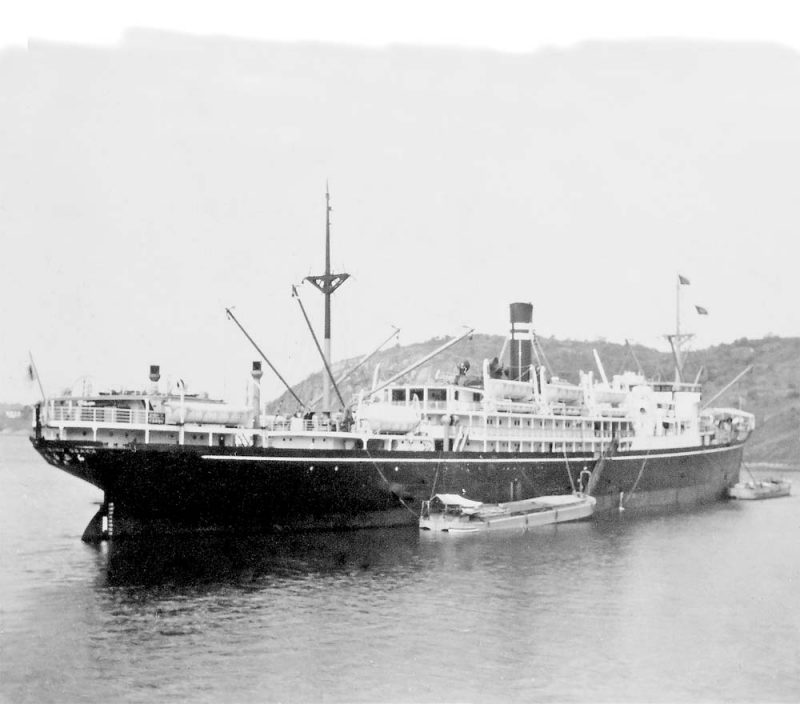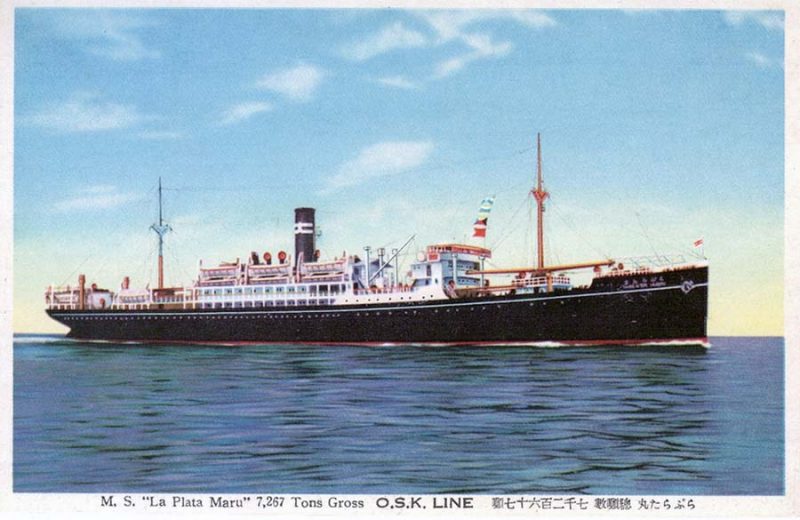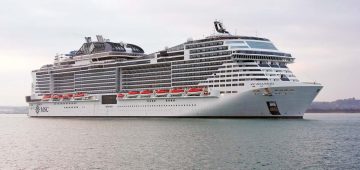The First Japanese Motor Passenger Liners

This trio of motorships were memorable for the very good reason that they were the first Japanese passenger motorships, and the first of their type under the Japanese flag to voyage around the world on liner services. They travelled westward on their emigrant service to Brazil via ports in the Far East, South Africa, and South America and returned via ports in the United States and the Panama Canal. The Japanese in the early 1920s had no knowledge or expertise in marine oil engines.
Thus, a dozen diesel engines were ordered from Swiss, Danish and British diesel engine manufacturers to be fitted in ships to be completed between 1923 and 1925. Six Sulzer two stroke cycle diesels were ordered from the Wintherthur engine works in Switzerland for fitting into the twin screw Santos Maru, La Plata Maru and Montevideo Maru, with the condition that the third set would be built under licence at Nagasaki, and that parts and technical personnel would be seconded to Japan so that Japanese marine engineers could acquire the necessary expertise. A pair of four stroke cycle Burmeister & Wain oil engines from Copenhagen were ordered for a twin screw coastal passenger and cargo ship, and a quartet of four stroke cycle diesel engines were ordered from Vickers of Barrow to fit into four coasters of 700 grt.
Osaka Shosen Kaisha (OSK)
Osaka Shosen Kaisha was established in 1884 and began to enter the Transpacific trade to the United States of America in 1906, with a ship sent at the end of that year with coal to San Francisco, and she returned to Japan with flour and wheat. The service prospered and large OSK emigrant and cargo steamers were built for this trade, with the OSK fleet having reached a big strength of 135 steamers by 1920. The biggest passenger steamers in the fleet were six of 9,500 grt with accommodation for 42 First Class passengers, 316 in Third Class, and up to six hundred steerage passengers in the ‘tween decks. The new trio of Santos Maru, La Plata Maru and Montevideo Maru were to be smaller at 7,300 grt with a capacity to carry 7,200 tonnes of cargo in five capacious holds. The keel of Santos Maru was laid at the Nagasaki yard of Mitsubishi Zosen Kaisha on 5th January 1925 and she was launched in September 1925, and after her new Swiss built diesels were fitted, she underwent speed trials in November 1925, and attained a speed of 16.419 knots at 4,690 bhp at 119 rpm in ballast over the measured mile, and a speed of 15.754 knots when half loaded and at 117.8 rpm. This more than satisfied the owners of OSK that the new trio of motorships would be able to achieve a tight schedule on their Round the World service.

Specification Of The Trio Of Motorships
The trio were specified to be built with three complete steel decks, namely and working downwards Awning Deck (or Weather Deck), Upper Deck and Second Deck, with the Third Class and steerage passengers occupying the full length of Upper Deck. There were two partial decks above in Bridge Deck and Boat Deck with the forty First Class passengers in cabins in some style ‘midships on Bridge Deck. The hull was subdivided into seven watertight bulkheads to give six compartments with three holds forward of the engine room and two aft. The cargo holds and ‘tween decks had a total capacity of 360,000 cubic feet, with separate large rooms on Second Deck for the important export trade from Japan of refrigerated goods, silk and rice. Awning Deck (or Weather Deck) had a deckhouse ‘midships 100 feet in length where the engineers and other members of the crew were accommodated. Forward of this crew accommodation on the starboard side was the Third Class Dining Room and on the port side various offices and crew members cabins. At the aft end of this deck was a deckhouse with the Third Class wash-houses, lavatories, laundry and the steering gear. In the space aft between numbers 4 and 5 hatches was a smaller deckhouse with the steerage class latrines and their entrance from the deck below. The seamen were accommodated in the fo’c’stle of this deck, and a second small deckhouse was sited between numbers 1 and 2 holds for the steerage class entrance from the deck below. Bridge Deck extended for a distance of 175 feet, and the main accommodation was that of the First Class cabins, and First Class Dining Room, and forward of these across number three hatch were the Officers cabins. In the two well decks at the level of Bridge Deck were the winch and derrick platforms, and at the stern were four lifeboats on the aft winch platform as well as the ship’s hospital further aft. Boat Deck was 120 feet in length with a further six lifeboats as well as the First Class Smoking Room and adjoining Verandah Cafe, and the First Class Social Hall or Lounge. The navigating bridge was at the forward end of Boat Deck with the Dayroom and Bedroom of the Master, Chart Room, Wireless Room, and Wireless Operat-or Cabin. The wheelhouse was situated on a flying bridge above the navigating bridge.

The public rooms and cabins for First Class passengers are now described:-
- The First Class Dining Room was immediately forward of their cabins on Bridge Deck with seating for all forty passengers in one sitting. The decor was in the ‘Colonial Renaissance’ style, with white and grey painted wooden panelling, and a matching ceiling of white panels. Large twin windows with top lights gave more than ample light through large wood framed sliding sashes of stained glass, and with gorgeous coloured floor tiles gave the room its neo luxury feel.
- The First Class Lounge or Social Hall on Boat Deck was beautifully decorated in full Japanese style of the Toyotomi era. The red and white fabric of the sofas, carver chairs and other Japanese furniture were a joy to relax in, and the walls had twin bands of brown wall cloth closely placed together with magnificent framed paintings of Mount Fuji and other iconic Japanese scenes in between. These painting were of course by a Japanese artist and drawn on silk in their usual style. The skylights of the ceiling were in elegantly designed stained glass, and were subdivided by brown wood into rectangular sections each with a large Japanese lantern, the latter also being placed centrally on all of the walls. The refined tone of this room was very apparent.
- The First Class Smoking Room on Boat Deck was a complete contrast with decor in the ‘Scottish Jacobean’ style with woodwork of polished oak. An imitation log fire was placed in the large fireplace and the room had a very cosy feeling with occasional tables and card tables for passengers to while away the voyage. As in the First Class Lounge, the central skylights were in elegantly designed stained glass, and the floor was fitted with beautiful coloured tiles.
- The First Class Entrance Hall had painted panel walls, while the stairwell and staircase were in polished oak.
- The First Class Verandah Cafe was an open room immediately aft of the First Class Smoking Room on Boat Deck, and had an ample number of cane settees, tables and chairs, with the walls of the bulkhead being roughly chipped to give imitation stone edging, the overall effect being of a small stone house partly open to the elements.
- First Class Cabins were all two berth, being twenty in number ‘midships on Bridge Deck for the forty passengers. They all were furnished with a comfortable sofa, a wardrobe with drawers and mirrors, a fold up toilet, an electric rotating fan, a steam radiator with separate controls, a beautiful carpet, and two large square metal sliding windows to allow air and a view to be obtained.
- Third Class and steerage class accommodation was very poor in contrast to that of First Class, with 110 Third Class passengers in cabins with ten, eight or six berths immediately forward of the machinery spaces, and the rest of this cargo deck had rudimentary portable fittings and space for up to six hundred steerage passengers or cargo, whichever was in most demand on each voyage. The promenading spaces for both of these classes of passenger were on the open portions of Awning Deck (or Weather Deck) above.
Careers of the Trio of Motorships
Santos Maru sailed on her maiden voyage in December 1925, and was followed by her sisters La Plata Maru in April 1926 and Montevideo Maru in August 1926. The main purpose of their Round the World service was to dramatically increase the Japanese population in Brazil, which grew from about 50,000 plantation workers in 1925 to 193,000 workers in 1935. A voyage from the Japanese ports via the Cape of Good Hope in this trio to Santos, the main port of disembarkation, was of 45 days duration. The full Round the World voyage was of 70 days duration, and thus each motorship completed four or five emigration round voyages per year. The full outward port rotation was:-
- Kobe, Yokkaichi, Yokohama, Kobe (second call), Hong Kong, Singapore, Colombo, Durban, Cape Town, Santos, Rio de Janeiro, Montevideo, Buenos Aires.
- Santos, Rio de Janeiro, Belem, Cristobal, Panama Canal, Los Angeles to Yokohama and Kobe.
- Optional calls if sufficient inducement included Shimizu, Port Elizabeth, East London, Rio Grande, Rosario, Santa Fe, La Plata, Victoria, Angra dos Reis, Maceio, Pernambuco, Fortaleza, Curacao, Havana, New Orleans and Galveston.
The peacetime voyages of the trio numbered over two hundred and were routine except for one of Santos Maru when she arrived at New Orleans on 11th June 1932. She was carrying an ‘alien’ passenger on a through ticket to Japan from Brazil, and the immigration officers issued a written warning for the officers to keep the ‘alien’ onboard at all American ports.

Unfortunately, he escaped at the next American port of call of Galveston and this was reported to the immigration authorities. Santos Maru sailed as usual from Galveston, with the ‘alien’ recaptured and deported on the following OSK Line sailing. Santos Maru was ‘impersonated’ by the German East Africa liner Windhuk in early December 1939 when the latter had been ‘trapped’ at Lobito since the beginning of the war and wanted to make a break out back to European waters and a German port.
Subscribe today to read the full article!
Simply click below to subscribe and not only read the full article instantly, but gain unparalleled access to the specialist magazine for shipping enthusiasts.






Comments
Sorry, comments are closed for this item